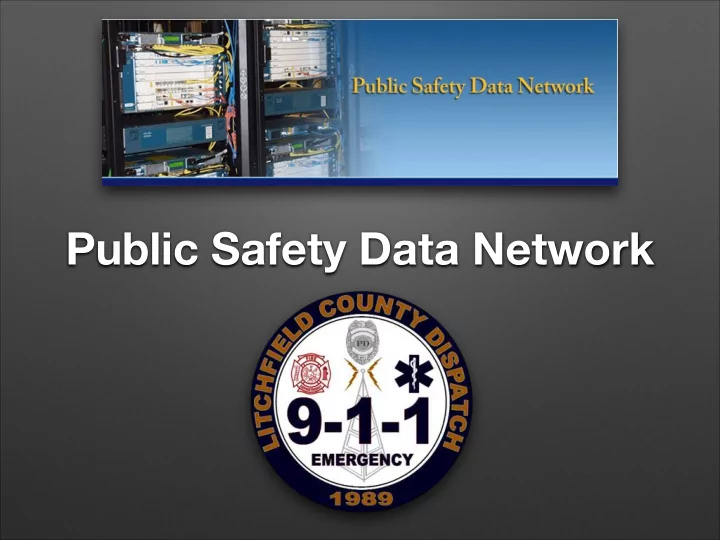

Public Safety Data Network
What is Fiber Optic Cable? Fiber Optic Cables are strands of optically pure glass as thin as a human hair that carry digital information over long distances using light.
Why Fiber Optic Cable? Less Expensive Several miles of fiber can be made cheaper than similar lengths of copper wire. More fibers can be bundled into a given-diameter cable than copper wire. *How Stuff Works
Why Fiber Optic Cable? Less Signal Degradation Light signals do not interfere with those of other fibers unlike electrical signals in copper wires. *How Stuff Works
What is the PSDN? Public Safety Data Network features: • High speed data connectivity to all 104 PSAPs and approximately 411 additional public safety locations • Fiber optic reliability (99.999%) • System architecture utilizing multiple rings and multiple touch points between the rings, constructed with carrier-class equipment provisioned with redundant facilities, all designed to withstand multiple failures without affecting service
What is the PSDN? • Highly secure implementation, partitioned to protect NG911 service in every instance • Significant savings over current network costs • Significant increase in efficiency • Easy upgradability to provide additional speed and/or connectivity without requiring "forklift upgrades" • Ability for each PSAP to serve as a connection point for other public safety locations (Local, State, and Federal) to connect into the network *DSET
PSDN Utilization Primary applications that will initially utilize the PSDN for transport and connectivity: Next-Generation 9-1-1 (NG911) Services DESPP , Connecticut On-Line Law Enforcement Communications Teleprocessing (COLLECT) System Statewide shared radio application for radio interoperability (commonly known as the "P25" controller) *DSET
How will the PSDN benefit LCD and the services we dispatch? LCD submitted an application to the Division of Statewide Emergency Telecommunications (DSET) and is currently in the process of meeting with DSET and the Bureau of Enterprise Systems & Technology (BEST) so the network can perform at the highest level based on the application LCD submitted. Within the main PSDN application submitted to DSET there were four sub- applications (A-D) that will perform different duties on the network.
Sub-Application A � This application will allow LCD to share our CAD with the services we dispatch and provide a status display screen at all the firehouses. The status screen will show active and past incidents for your respective department as well as road closures in your town.
Sub-Application B � This will provide a direct voice c o n n e c t i o n f o r e m e r g e n c y communications between LCD and each fire station or EMS facility. The main goal is to use this voice connection as a supplement for the Intracounty radio system in a widespread incident.
Sub-Application C This will allow radio traffic to be routed through the fiber and the microwave. It will pick the best path for transport dependent on current conditions. � This will also allow current sites, that use expensive T1 transport to utilize fiber instead. It will also allow new sites that currently have fiber installed to be affordably added to the current simulcast system to bridge coverage gaps.
Sub-Application D This will provide an offsite backup for our new virtual environment.
Under Development… Direct access to service reports. Capabilities to self-dispatch during large scale incidents. Direct Firehouse Software Interface.
Raspberry Pi Small, affordable credit card sized micro-computer. ~$100 includes keyboard, mouse, power supply, SDcard, case and HDMI cable.
WAN/Internet Pricing Education/Municipality Pricing $7.79/MB/month + $113.35 port fee/month Minimum of 10MBs Municipality: 10Mbps = $191.25/month **Non-Municipality: 10Mbps = $478.08/month**
Never touch or unplug PSDN equipment. Unplanned disruption to this equipment could disrupt service to other emergency locations. If you are having trouble with PSDN equipment or would like it moved to another location within your facility please contact DAS/BEST: (860) 622-2300.
Building Access & Technical Contacts LCD is in process of building a contact list in case access to your building or technical data is required. We are looking for a technical contact as well as a physical access contact. Please e-mail these contacts directly to; The LCD Systems Administrator: bmirizzi@lcd911.com
My Contact Information Brian Mirizzi Systems Administrator (860) 626-7521 bmirizzi@lcd911.com
Recommend
More recommend